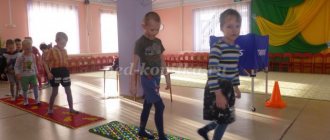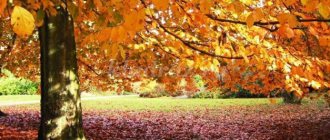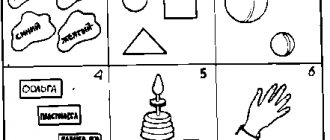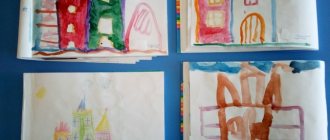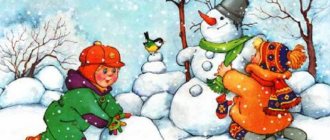Summary of educational activities in the senior group of the preschool educational institution “Winter Fun” (composing a story based on a picture)
- January 3, 2021
Program content:
- Improve children's ability to write a descriptive story based on a picture.
- Strengthen the ability to present the content of a picture in detail and logically; independently invent events preceding and following those depicted in the picture.
- Practice composing sentences and incorporating them into a coherent statement.
- To develop children's coherent speech in story writing, attention, and memory.
- Develop the ability to listen to the answers of your comrades to the end, without shouting.
Materials and equipment: painting “Winter Fun”, stereo system, DVD with music by A. Vivaldi “Winter”, board, magnets. Preliminary work: conversations with children about winter and winter activities, selection of definitions, selection of synonyms for the word quickly - swiftly, dashingly, at full speed, like an arrow, in an instant, immediately, etc.
GCD move
Educator: Guys, let's guess the riddle and find out what we will talk about. So listen to the riddle.
I dusted the paths, decorated the windows, and gave joy to the children. And I went for a sledding ride. (Winter).
A short conversation on the following questions:
- Guys, what is this riddle about? (About winter).
- What is our winter like? (Severe, white, silver, fluffy, snowy, frosty, cold).
- What happens in winter? (Snow is falling, the wind is howling, rivers are freezing).
Well done guys, you remembered all its signs.
Exercise “Name the action” (with a ball).
Educator: I will say an unfinished sentence, and the one to whom I pass the ball will finish the word I didn’t say.
- In winter there is a snowstorm... (sweeping).
- At night the wind in the pipes... (howls, howls).
- From a snow cloud, snowflakes... (fall, fly, spin).
- There is a hungry wolf in the forest in winter... (howls).
- For the winter, the bear is in a den...... (falls asleep).
- Frost on the cheeks and nose... (stings).
- In winter, the water in the river... (freezes).
- Frost on tree branches... (glitters).
- In winter, snow is all around... (covers).
- Trees in winter... (sleep).
- Grass under the snow in winter... (warming up).
- In winter, insects... (hide).
Well done! You know winter phenomena well. Do you know what winter cannot be without? Let's continue playing.
Game "Third Man".
Educator: Now listen to my winter words, one of the three words will be superfluous, you need to name it, explaining your decision:
1. January, February, winter.
2. Snowballs, sleds, skates.
3. Blizzard, skiing, frost.
4. Snowball, snowman, bullfinch.
Right! What smart people and smart girls! You know everything about winter and winter phenomena. Guys, do you think winter is good or bad?
Suggested children's answers:
- It’s good in winter because there is a lot of snow and you can build a snowman and have snowball fights.
- It’s good in winter, you can sled down the mountain.
- In winter comes the best holiday - New Year, and this is very good.
- It’s bad in winter, when it’s very cold, we don’t go for walks.
- Birds feel bad in winter - they are cold and have nothing to eat.
- In winter it’s nice and fun, we go skiing and play hockey.
For each answer, the teacher draws a circle of snowballs “good”, “bad”.
Educator: Guys, look at the snowballs and draw a conclusion: which snowball is bigger? There are more good things in winter: the kids love to play, have fun, and play sports.
But what games do they like to play? I'll tell you some riddles :
My new friends are both brilliant and light, And they frolic with me on the ice, and are not afraid of the frost. (Skates).
They run forward with their noses in the air. Two stripes follow them. (Skis).
Oh, it's snowing! I'm bringing out my friend horse. I fly down the hill on it, and drag it back. (Sled).
Physical exercise.
- “Winter has finally come, (children spread their arms to the sides)
- The houses have become white (they fold their hands over their heads)
- It's snowing outside (move hands from top to bottom)
- A janitor sweeps the street (imitate)
- We are sledding (squat, arms extended forward)
- We write circles on the skating rink (put our hands behind our backs and spin slowly)
- Skiing deftly, (imitate)
- And we all play snowballs. (They make and throw snowballs)"
It's good in winter - a lot of games and fun. What can you do in winter? (Sledding, skiing, skating, building forts, making snowmen, etc.).
Dynamic pause.
Educator: Now we will play. You (points to half of the group) will be snowflakes, and you (the other half) will be the wind. The game is repeated twice, the subgroups change roles. Snowflakes are spinning, running on tiptoes, the breeze is resting. As soon as I say “the breeze has woken up,” the breeze blows, shhh, and the snowflakes settle.
Didactic ball game “Name it kindly”
(Children catch the ball, give answers to the teacher with a diminutive suffix):
- Snow - snowball
- wind - breeze
- star – asterisk
- winter - winter
- Christmas tree - Christmas tree
- snowflake - snowflake
- sun - sunshine
- snowman - snowman
- star - asterisk.
Educator: Many poets, writers and artists depicted winter in their works. And in our art gallery there is a picture about winter. (The teacher draws the children’s attention to the painting “Winter Fun”).
Educator: In a real art gallery there is a guide who tells all visitors interestingly about the paintings. Do you want to try to become a tour guide, compose and tell a story based on this picture?
Communication by picture:
- What time of year is shown here?
- Why did the children come to the hill, and what happened there?
- What were the children doing? (Children sledding down the mountain, making a snow woman, skiing, playing snowballs).
- How do the guys play in winter? (Fun, joyful, friendly, interesting, fervent).
- At the end of the story, tell me what mood the guys were in and why you decided that way.
– Remember the words that will decorate your story and make it interesting. Do not forget that children can be called differently when telling stories (children - kids, guys, boys and girls, they).
Children's stories based on the picture.
Reflection.
- What did we do today? You did your best today and made up different interesting stories. It seems to me that this story will be interesting for your moms and dads to listen to at home.
As a farewell gift, I want to give you pictures – “Winter Fun” coloring pages. Winter has only white paint, but you can color them with your colored pencils.
Author: Gumerova Rezeda Khalidovna, teacher at MBDOU DS KV “Beryozka”, Novy Urengoy, Tyumen region.
Progress of the lesson
Educator: Guys, let's say hello to the guests.
Q. What time of year is it now? (Winter.)
Q. Name the winter months . (December January February.)
V. Correct. Today we will talk about winter. What happens in nature in winter?
(It’s getting cold. The sun is not warm enough. It’s very cold outside. There’s snow all around.)
V. Well done. What kind of trees are there? (White.)
Q. What lies on the roofs of houses and on the street? (Snow.)
Q. What do people wear in winter? (Hat, fur coat, warm boots.)
Topic “CHILD SAFETY ON THE STREET”
Contents of the work: acquaintance with the street, transport, zebra crossings, traffic lights, basic rules of behavior on the street.
Cognitive practical activity. Targeted walk down the street
Goal: to clarify children’s ideas about the street, the rules of behavior on it and types of transport.
While walking along the street, the teacher reinforces the children's ideas about the names of the locality and the street they are walking on, and talks about the rules of safe behavior on the street. Informs about the structure of the street: there are houses on both sides, they are separated by a wide road (roadway), along which different cars drive.
On both sides of the roadway there are narrow paths for people (sidewalks). For safety, the roadway is separated from the sidewalk by a curb and a lawn. Children name the transport that is moving (bus, car, minibus, ambulance, trolleybus, tram, truck, etc.). During walks, the teacher develops the ability to see beauty in the environment.
Artistic activity. Construction of “City Street”
Goal: to consolidate children’s ideas about the street.
Material: large construction sets, dolls, cars, fences, trees.
With the help of bars, children lay out wide and narrow paths, clarifying their purpose. Various houses are built from bricks, cubes, and prisms, and the construction is supplemented with details. Together they come up with a name for the street. They use toys to play with the building.
Cognitive practical activity. Introducing ways to cross the street
Goal: to consolidate children’s ideas about the structure of the street and basic traffic rules.
Material: model of a city street with a pedestrian crossing, a set of toys (figurines of people, cars, model of a traffic light).
Q. Guys, we are on the street. Tell me what do you see? (Houses, a wide road with cars on it, a narrow road for people.) What separates the roadway from the pedestrian path. (Border, lawn.) Where are the cars? (On the roadway.
) Is it possible for pedestrians to enter the roadway? Why? (Children's answers.) Can children go outside without adults? (No. It's dangerous.) What if a pedestrian needs to cross to the other side of the street? (Children's answers.
) What do red, yellow, green traffic lights mean? (Children's answers.)
Emphasize that pedestrians have assistants for safety: a pedestrian crossing and a traffic light. The traffic light has three color signals: if it is red, you cannot move; if the yellow signal is on, this means that you need to get ready to move so as not to delay anyone; If the green signal is on, movement is allowed. At the pedestrian crossing, cars stop to let people through.
Game activity. Didactic game “Walk down the street”
Goal: to consolidate children’s ideas about the structure of the street and places for pedestrians to move.
Material: small construction set, dolls, animals, cars, trees, wide and narrow strips of paper.
Progress of the game
Children are invited to build a street from a construction set, name its parts, places for pedestrians and cars to move. Then the children act out various situations of crossing the street.
Game activity. Outdoor game “Colored Cars”
Goal: developing the ability to respond to a signal by changing the direction of movement.
Material: multi-colored rudders and flags.
Progress of the game
Children (cars) are placed along the wall or along the edge of the site, each with their own steering wheel color. The presenter has a set of flags of the same colors as the steering wheels. He raises the flag. Children with the same color steering wheel run around imitating the movement and sound of a car.
When the leader lowers the flag, they stop and go to the garage. Children's attention is drawn to moving carefully and avoiding accidents. To complicate the game, the presenter can raise 1-3 flags at the same time.
Cognitive practical activity. Traffic light monitoring
Goal: to consolidate children’s understanding of how traffic lights work and the rules of behavior on the street.
During the walk, the teacher asks the children to remember the name of the city, their street. Draws attention to the diversity of passenger transport in the city.
When approaching a pedestrian crossing, remind them that traffic lights are installed at intersections and pedestrian crossings. They do this so that cars and pedestrians do not interfere with each other, they know when and who can cross the street, so that it is safe.
The guys look at the traffic light, name the colors of its signals and their meaning. Monitor the movement of cars and pedestrians. Pay attention to the fact that there are many cars and trucks moving along the road, and no one interferes with each other.
This is because drivers follow traffic rules. Pedestrians also obey traffic lights. Children remember that the carriageway of the street is intended for cars, the sidewalk is for people, and they establish the rules: pedestrians can cross the street only at a pedestrian crossing, when the traffic light is green, pedestrians are not allowed to enter the roadway.
The teacher summarizes the rules of behavior on the street: you need to cross the road hand in hand with an adult, you cannot run or play. At the kindergarten site, he organizes the game “Children and the Traffic Light”: when the teacher shows a green circle, the children walk and run around the site, when it is red, the children stop and stand.
Communication. Conversation on the poem “Ball” by S. Marshak
Goal: to consolidate ideas about the rules of behavior on the street.
The teacher reads the poem “Ball” by S. Marshak to the children, then asks questions:
-What is this poem about? (Children's answers.)
— Why did the ball burst? (Rolled out onto the road and fell under the wheels of a car.)
— Is it possible to play with a ball on the street? (Children's answers.)
- Why can’t we play outside? (Is it dangerous.)

